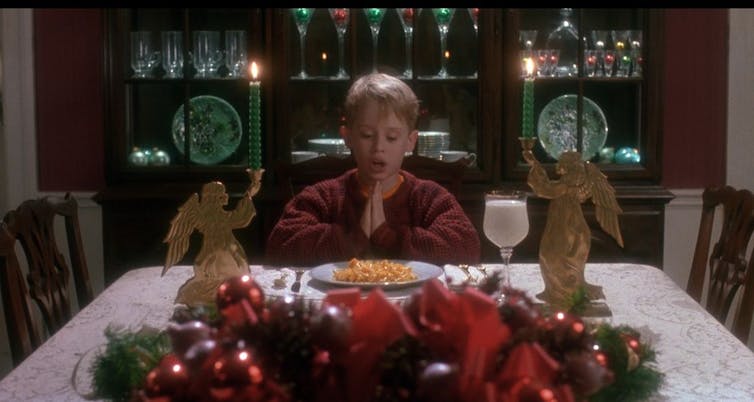Jane Barnwell
University of Westminster

Christmas movies are so often linked to classic themes of redemption and rediscovery of innocence. Old favourites such as Home Alone, Love Actually, The Wizard of Oz, It’s A Wonderful Life, Miracle on 34th Street, The Holiday and Elf reappear on our screens in a festive ritual as predictable as the turkey dinner itself. So what is it about these films that endures, and why do we feel drawn to watch again and again?
Within all of these films, the home – or the return home – emerges as an important ingredient in the festive formula. My research has suggested that the private environment of the home is often a key to character, where ideas can be distilled and accentuated. Personal space can mirror a character’s psychology, the interior décor reflecting interior landscape and layers of back story.
Character and story are closely entwined in the domestic setting, which often undergoes transformation to signify changes taking place in the narrative arc. Myths have been cultivated around the house as a safe secure structure embodying family values.
Screen homes can often appear as familiar as our own, especially those we return to regularly in the annual recycling of Christmas classics. In these recognisable places, we are reassured by the sense of stability and the knowledge of what happens next – comforted by characters we know and love behaving exactly as we expect them to.
The homes featured in these films often perpetuate popular myths and include a warm welcome from a surrogate family that we may well prefer to our own. A reliable set of characters for us to cosy up to for a couple of hours. A sense of belonging comes with the knowledge of narrative, characters and place. We feel at home.
Whether it is the nurturing warmth of the Browns’ home in Paddington 2, the chaotic but ultimately resilient Byers’ bungalow in Stranger Things or the desirable cosy country cottage in The Holiday, people and places have been created that we recognise and wish to return to.
The home as sanctuary
Christmas classics often raise the stakes and heighten the importance of home further. For example in Home Alone, the home becomes a protective weapon to ward off the would be burglars. Miracle on 34th Street uses a traditional home with a white picket fence to prove that Santa Claus is real. And in The Holiday, a house swap between Cameron Diaz and Kate Winslet’s characters enables both women to fulfil their potential.
Christmas movies are often preoccupied with both the physical and metaphysical return home. In narrative terms, this closes the loop and gives a sense of completion. The quest for home is satisfying at any time of year – but it is particularly poignant at Christmas when we remember childhood Christmases and there is a pull to return to our families.
We return home for Christmas through these films – even if we do not physically travel back to our own homes and families. Watching a familiar film can transport back home at Christmas, whoever we are and wherever we are from. The transportation device also operates across time – as in the many film adaptations of A Christmas Carol we are granted the gift of revisiting our Christmases past, present and future where we can reconnect with our childhood and humanity. A range of unique memories can be triggered, allowing us to connect the dots all the way back through a trail of celluloid.
Home as redemption
The redemptive possibilities of new beginnings and rebirth resonate with the themes of Christmas itself chiming with hope for the year ahead. Miracles are often entwined in Christmas films, such as Miracle on 34th Street, A Christmas Carol and It’s A Wonderful Life.
George Bailey (James Stewart) is on the verge of killing himself after having a really bad day, when he meets Clarence a trainee angel. Clarence subsequently earns his wings by helping George see the positive impact his life has had. At the heart of this story is the Bailey family home, which plays a pivotal role throughout the movie. Beginning as a derelict shell it gradually transforms to reflect the growing family. “The drafty old house”, as George calls it, has become something to escape from. But by the end of the film George gratefully returns home to his family and friends in a wonderfully life affirming Christmas scene.
Christmas movies tap into a nostalgic wish to return to Christmas past and create an imagined community that audiences feel a sense of belonging to and a metaphorical return home. This is welcome at any time of year – but Christmas has special resonance, as this is when we traditionally return home to our families in an annual ritual and the films we consume when we get there are entwined in this festive tradition.
We are drawn to these films because they contain enduring truths that continue to resonate with our own lives. So instead of complaining that there’s nothing decent on TV this Christmas, sit back and allow yourself to be transported in time and place. It’s a kind of magic in itself.
Jane Barnwell, Senior Lecturer in Contemporary Media Practice, University of Westminster
This article is republished from The Conversation under a Creative Commons license. Read the original article.
Share this article with your friends, and let more people know about The BFD









